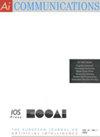Multiple analogical proportions
IF 1
4区 计算机科学
Q4 COMPUTER SCIENCE, ARTIFICIAL INTELLIGENCE
引用次数: 3
Abstract
Analogical proportions are statements of the form “a is to b as c is to d”, denoted a : b : : c : d, that may apply to any type of items a, b, c, d. Analogical proportions, as a building block for analogical reasoning, is then a tool of interest in artificial intelligence. Viewed as a relation between pairs ( a , b ) and ( c , d ), these proportions are supposed to obey three postulates: reflexivity, symmetry, and central permutation (i.e., b and c can be exchanged). The logical modeling of analogical proportions expresses that a and b differ in the same way as c and d, when the four items are represented by vectors encoding Boolean properties. When items are real numbers, numerical proportions – arithmetic and geometric proportions – can be considered as prototypical examples of analogical proportions. Taking inspiration of an old practice where numerical proportions were handled in a vectorial way and where sequences of numerical proportions of the form x 1 : x 2 : ⋯ : x n : : y 1 : y 2 : ⋯ : y n were in use, we emphasize a vectorial treatment of Boolean analogical proportions and we propose a Boolean logic counterpart to such sequences. This provides a linear algebra calculus of analogical inference and acknowledges the fact that analogical proportions should not be considered in isolation. Moreover, this also leads us to reconsider the postulates underlying analogical proportions (since central permutation makes no sense when n ⩾ 3) and then to formalize a weak form of analogical proportion which no longer obeys the central permutation postulate inherited from numerical proportions. But these weak proportions may still be combined in multiple weak analogical proportions.多重类比比例
类比比例是一种形式为“a与b之比就像c与d之比”的陈述,表示为a: b:: c: d,可以适用于任何类型的项目a, b, c, d。类比比例作为类比推理的基石,是人工智能的一个有趣工具。作为对(a, b)和(c, d)之间的关系,这些比例应该遵循三个假设:反身性、对称性和中心置换(即b和c可以交换)。类比比例的逻辑建模表示,当这四项用编码布尔属性的向量表示时,a和b的不同方式与c和d相同。当项目是实数时,数字比例——算术比例和几何比例——可以被视为类比比例的典型例子。从以向量方式处理数值比例的旧做法中获得灵感,其中使用形式为x 1: x 2:⋯:x n:: y 1: y 2:⋯:y n的数值比例序列,我们强调布尔类比比例的向量处理,并提出了布尔逻辑对应物。这提供了类比推理的线性代数演算,并承认类比比例不应孤立考虑的事实。此外,这也使我们重新考虑类比比例的基本假设(因为当n大于或等于3时中心排列没有意义)然后将类比比例的弱形式正式化它不再服从从数字比例继承的中心排列假设。但是这些弱比例仍然可以组合成多个弱类比比例。
本文章由计算机程序翻译,如有差异,请以英文原文为准。
求助全文
约1分钟内获得全文
求助全文
来源期刊

AI Communications
工程技术-计算机:人工智能
CiteScore
2.30
自引率
12.50%
发文量
34
审稿时长
4.5 months
期刊介绍:
AI Communications is a journal on artificial intelligence (AI) which has a close relationship to EurAI (European Association for Artificial Intelligence, formerly ECCAI). It covers the whole AI community: Scientific institutions as well as commercial and industrial companies.
AI Communications aims to enhance contacts and information exchange between AI researchers and developers, and to provide supranational information to those concerned with AI and advanced information processing. AI Communications publishes refereed articles concerning scientific and technical AI procedures, provided they are of sufficient interest to a large readership of both scientific and practical background. In addition it contains high-level background material, both at the technical level as well as the level of opinions, policies and news.
 求助内容:
求助内容: 应助结果提醒方式:
应助结果提醒方式:


